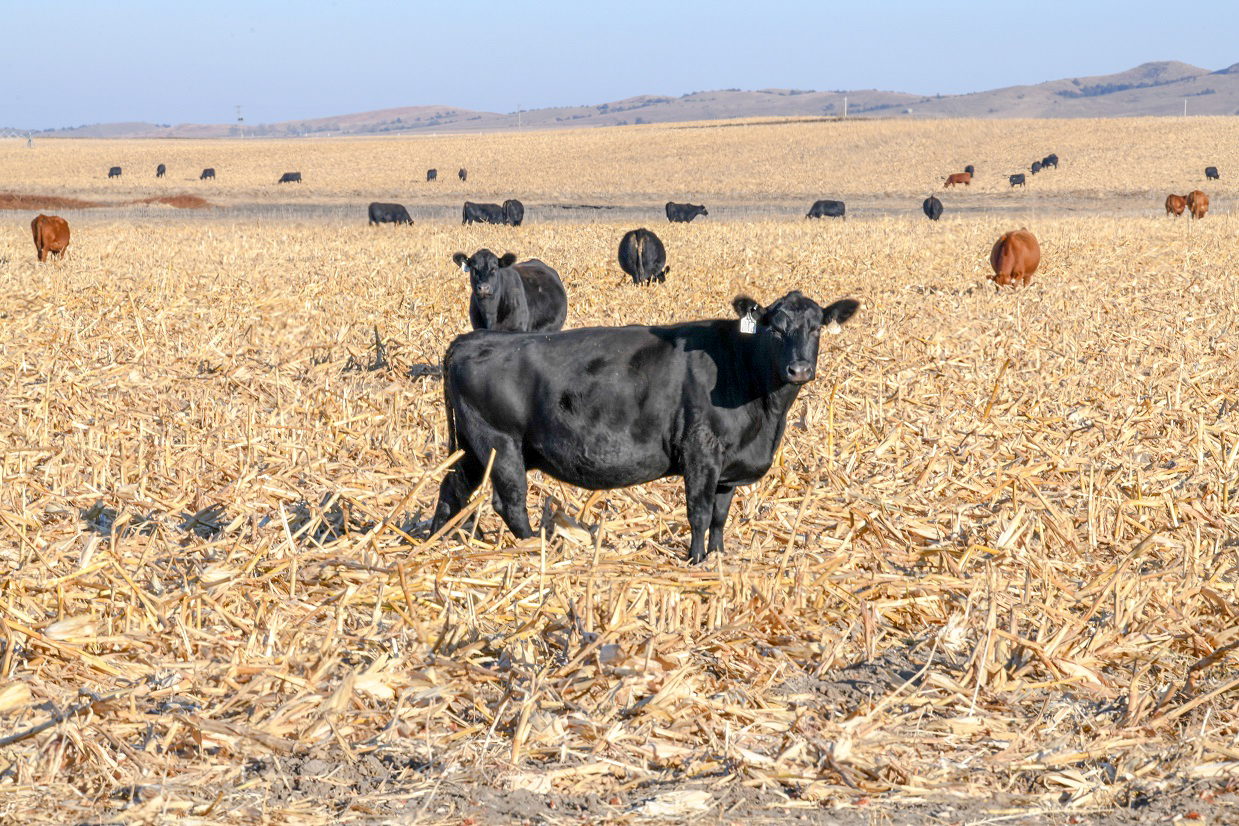Karla H. Wilke, UNL Cow/Calf Systems and Stocker ManagementMary Drewnoski, Nebraska Extension Beef Systems SpecialistKacie McCarthy, UNL Cow-Calf Specialist

With approximately 9.8 million acres of corn yielding an average of 182 bushels/acre, cornstalk residue can be an accessible and economical winter grazing forage option for producers in Nebraska. Historic research at the University of Nebraska has suggested cattle select mostly dropped corn, husks, and leaves. The total digestible nutrients (TDN) of the selected diet can be variable, but tends to range from 50-60% TDN. Variability can be attributed to many factors including stocking density, harvest methods and conditions, weather, and grazing duration. Additionally, producers must remember the highest forage quality in a residue field is available at the onset of grazing. As the more desirable plant parts are selected, the quality of the remaining residue decreases. Therefore, questions often arise about proper supplementation for cattle grazing residue fields.
Weaned Growing Calves
While maximizing gain is typically not the goal for producers grazing weaned calves on cornstalks, supplementation is still necessary to achieve the desired gain for the winter. Growing calves not receiving supplement will lose weight. If a producer wants 600-pound calves to gain 1.5 pounds/day, the calves will need 9.2 pounds of TDN and 1.53 pounds of crude protein (CP). Grazing cornstalk residue alone, the calves would likely only consume 6.8 pounds of TDN and 0.66 pounds of CP, falling very short of the desired outcome. Research at the University of Nebraska has shown calves grazing cornstalks and supplemented with 4 pounds of dried distillers grains (as is basis) per day will gain 1.5 pounds per day. Have a different target rate of gain in mind? Then check out the table in Low Cost Option for Growing Calves: Corn Residue Grazing with Distiller Supplementation
Dry Pregnant Cows
Fortunately, the dry pregnant cow in only the second trimester of pregnancy has a rather low nutrient requirement if she is in moderate to good body condition (5-6 on a 1-9 scale). A mature cow in moderate condition could maintain her weight consuming approximately 26 lb of residue (DM basis). A five-year study at the University of Nebraska found that mature cows supplemented 2.2 pounds per day of dried distillers grains (DM basis) experienced an increase in body condition (5.4 to 5.6) while non-supplemented cows maintained a BCS of 5.4 from October to February. No difference was detected in calf birth weight or subsequent pregnancy rate. While weather conditions, residue availability, and previous BCS of the cows all play a role in the need for supplementation, producers should be aware that little to no protein or energy supplementation may be needed for the mature pregnant beef cow until very late gestation. However, a free choice mineral to provide supplemental phosphorus, copper, zinc and vitamin A would be needed. For a free choice mineral, with a target intake of 4 oz per day, suggested concentrations would be 4 to 5% phosphorus, 1500 to 2500 ppm copper, 3000 to 5000 ppm zinc and 140,000 IU/lb of vitamin A.
Lactating Cows and Nursing Calves
Lactation increases the energy requirements of the cow substantially. If a lactating 1350 pound cow could eat 30 pounds (DM basis) of residue it would only supply about 13-15 pounds of TDN which is short of the energy needs of lactation. An energy supplement is needed, not just a protein supplement at this point. For example, consuming 1 pound (as is basis) of a lick tub, would not supply 1 pound of TDN and the cow would need 3-5 pounds of supplemental TDN to meet her needs just for maintenance, without consideration for mud and weather conditions.
The nursing calf also needs supplemental nutrition in addition to milk while grazing cornstalks. Calves will graze the stalks and likely manage to consume some of the supplement given to the cows.
Summer calving cows
A University of Nebraska study (Effects of Production System on Cow and Calf Performance) indicated supplementing summer born (July/August) pairs after breeding on cornstalks with 5.5 pounds of dried distillers (DM basis) resulted nursing calves gaining 1.43 pounds per day from December to March, while confined nursing calves gained 2.1 pounds per day. However, because the cornstalk residue was an economical forage resource, the net income was more for the lighter residue grazing calves compared with the confined calves. Producers who desire more gain during residue grazing might consider a method of creep feeding or creep grazing.
Fall calving cows
Producers will want to pay special attention to the fall calving cow grazing cornstalk residue during peak lactation, just prior to breeding. This is a time when her nutrient needs are the highest and need to be met to provide the best chances for rebreeding. Supplementing 8 pounds as is of dried distillers per pair would provide enough energy to meet the demands of the cow as well as provide some supplement for the calf.
Producers often ask about supplementing alfalfa on cornstalks, but for the lactating cow in peak lactation, the energy in alfalfa is simply not enough to meet their needs. Producers who would like assistance in developing a supplemental ration for lactating cows on cornstalks are encouraged to contact their local university extension beef personnel for assistance.
Cornstalk residue is an economical forage resource across Nebraska, which can help producers reduce annual cow costs. Supplementation strategies can be cost effective when producers understand the nutrient needs of the cattle grazing residues and design supplementation programs accordingly.
Interviews with the authors of BeefWatch newsletter articles become available throughout the month of publication and are accessible at https://go.unl.edu/podcast.
University of Nebraska-Lincoln
